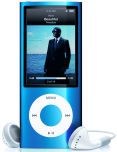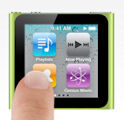Lifeproof iPhone Tough Case
 The LifeProof tough case for iPhone 4/4S offers serious protection from both rough impacts and nasty environments, but I've also found it to be great for everyday use.
The LifeProof tough case for iPhone 4/4S offers serious protection from both rough impacts and nasty environments, but I've also found it to be great for everyday use.
The LifeProof case is fully sealed for full IP-68 rating against intrusion from dust or water:
- It's dirtproof, for protection from even fine micro-particles, so you can confidently use your device on a gritty windy beach, or off-road in a dusty plain.
- It's waterproof, to 2 meters (6.6 ft), so you can shoot photos underwater, or even listen to music with the waterproof headphone adapters. And you can still use your phone in bad weather or even in the shower.
- It's snowproof, since even melting snow and ice can't wick in through pooling or capilliary action.
- It's shockproof, providing shock and impact protection up to a drop of 2 meters (6.6 ft) onto concrete (MIL-STD-810F-516.5).
And LifeProof does all this without ending up with a bulky, clunky case. The iPhone case adds 1/16” (1.5mm) from the center of the phone, and weighs under 1 oz. (28g), so it still travels comfortably in a pocket.
You install the case by sliding the iPhone into the body of the case, face down, so the top power button and side volume buttons and mute switch pop into the associated elements of the case. Then snap on the back, and close the bottom latch over the dock connector. Finally, screw in the headphone jack cover, and your iPhone is hermetically sealed, yet still fully accessible and functional.
(LifeProof does recommend you try out a new case underwater, before you insert the iPhone, just in case.)
There are some trade-offs for this protection, of course:
- The iPhone display still shows clearly through the screen cover, although you do need to learn to press a little harder, especially to activate smaller buttons. (I've also noticed an unexplained oil-stain-like distortion that grows on the screen over time, which disappears when you pop open the case. On the other hand, there's a nasty gouge that is thankfully in the screen of my case, and not in the iPhone display.)
- The headphone jack is harder to access if you often use earphones or headphones. LifeProof includes a screw-in headphone adapter, since most typical headphone plugs do not fit into the access above the headphone jack.
- The power and volume buttons are covered, but still easily usable. The case has a subtle bumpers on the side to protect the buttons.
- The front and back cameras are covered by an additional window. LifeProof uses double AR-coated optical glass lenses, and I have not noticed any problem with loss of clarity.
- The case also covers the iPhone speakers, but again I have not noticed a big deal, and LifeProof even claims that it improves bass and mid-frequency using the back of the case as a sub-woofer.
So while I have chosen to not deliberately drop or submerge my personal iPhone, the LifeProof case certainly has done its job in protecting the phone through the travails of normal life, including winter snow, hot and dusty Texas spring, damp and humid ocean and lakeside beaches, and several heart-stopping accidental drops.
The LifeProof case for iPhone 4/4S is available for $79, in black, white, and a variety of bright colors.
![]() Find the Lifeproof iPhone Tough Case on Amazon.com
Find the Lifeproof iPhone Tough Case on Amazon.com

 Pivothead actually has several lines of stylish sunglasses, some with interchangeable lenses (gray, yellow, clear; polarized and not), or you can order prescription versions.
Pivothead actually has several lines of stylish sunglasses, some with interchangeable lenses (gray, yellow, clear; polarized and not), or you can order prescription versions.
 The new iPod touch (generation 5) basically catches up with the previous-generation iPhones and iPads, with the bonus of a 4-inch widescreen Retina display (same res as the iPhone 5, up from 3.5").
The new iPod touch (generation 5) basically catches up with the previous-generation iPhones and iPads, with the bonus of a 4-inch widescreen Retina display (same res as the iPhone 5, up from 3.5"). The original nanos from 2005 and 2006 were click-wheel music players, with a simple 1.5 inch display for choosing music, plus built-in games, calendar, contacts, and notes.
The original nanos from 2005 and 2006 were click-wheel music players, with a simple 1.5 inch display for choosing music, plus built-in games, calendar, contacts, and notes.  With the nano generation 3 in 2007, Apple upgraded the nano to a full-fledged video player with a 2 inch color display with the same resolution as the iPod video. It also provided more advanced interface features like Cover Flow to flip through album covers.
With the nano generation 3 in 2007, Apple upgraded the nano to a full-fledged video player with a 2 inch color display with the same resolution as the iPod video. It also provided more advanced interface features like Cover Flow to flip through album covers. 
 Then the nano gen 5 from 2009 kept the same design, but stepped back up even closer to iPhone/touch kind of capabilities as an almost-but-not-quite iOS device, keeping the narrow design but adding a slightly larger 2.2 inch display plus a video camera, microphone and speaker, FM radio, and pedometer.
Then the nano gen 5 from 2009 kept the same design, but stepped back up even closer to iPhone/touch kind of capabilities as an almost-but-not-quite iOS device, keeping the narrow design but adding a slightly larger 2.2 inch display plus a video camera, microphone and speaker, FM radio, and pedometer.  But in 2010, Apple swung totally in the other direction, revamping the nano gen 6 as a shuffle-style music player, but trading in the control pad for a touch-screen display. The new design had the shuffle's rectangular shape, with a 1.54 inch display over the entire area.
But in 2010, Apple swung totally in the other direction, revamping the nano gen 6 as a shuffle-style music player, but trading in the control pad for a touch-screen display. The new design had the shuffle's rectangular shape, with a 1.54 inch display over the entire area.  Which brings us to last week's announcement of the iPod nano generation 7, which jumps back into the widescreen media player world, following the example of the new iPod touch and iPhone 5 -- but with a custom interface still separate from the iOS world
Which brings us to last week's announcement of the iPod nano generation 7, which jumps back into the widescreen media player world, following the example of the new iPod touch and iPhone 5 -- but with a custom interface still separate from the iOS world The smaller Big Blue Live is mini enough to pack for trips (~ 5 x 2 1/2 x 2 1/3 in. and 1.4 lbs.), but large enough to pack stereo speakers for a strong sound, plus a down-firing passive radiator for bass, with a total of 4 W.
The smaller Big Blue Live is mini enough to pack for trips (~ 5 x 2 1/2 x 2 1/3 in. and 1.4 lbs.), but large enough to pack stereo speakers for a strong sound, plus a down-firing passive radiator for bass, with a total of 4 W.